- Scientific name: Xyris montana Ries
- Species of Greatest Conservation Need (MA State Wildlife Action Plan)
Description
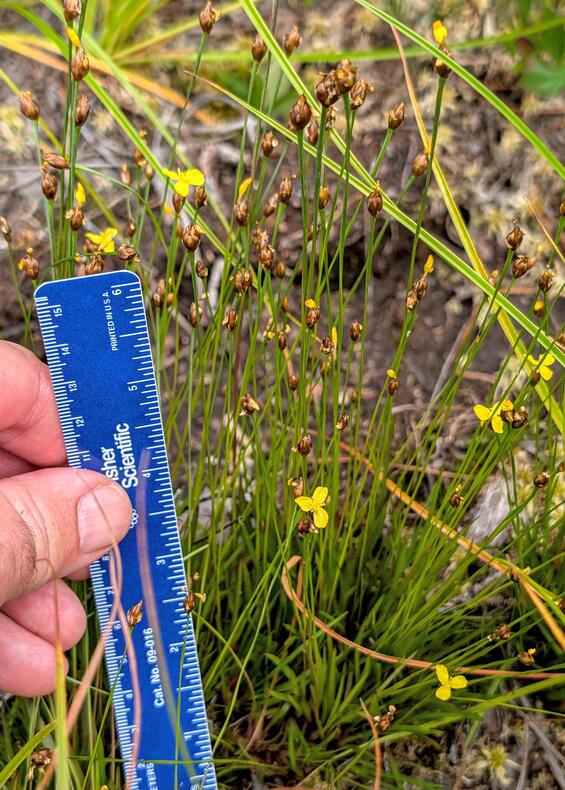
Image by Robert Wernerehl.
Northern yellow-eyed grass, (Xyris montana), is a slender perennial of the yellow-eyed grass family of monocots known botanically as the Xyridaceae. The plants are rhizomatous with shallow fibrous roots and sometimes forms dense colonies. The leaves arise from the rhizome and are all basal, linear with parallel veins, deep green, 4-15 cm (1.6-5.9 in) long and 0.8-2 mm (0.03-0.08 in) wide. The portions of the leaves which enclose the adjacent leaves is called a sheath. The sheaths of northern yellow-eyed grass are often reddish and minutely papillose. The inflorescence is produced on a wiry stem up to 30 cm (12 in) tall, but in the field, averaging 15-20 cm (5.9-7.9 in) in height. The flowering spikes of yellow-eyed grass species are 4-8 mm (0.16-0.31 in) long, dense, somewhat conelike structures with overlapping bracts, ovoid in shape. The small yellow flowers have three petals and are solitary in the axils of the bracts. The flowers have three unequal sepals which are partially or completely concealed behind the bracts. Both the petals and the innermost sepal are deciduous, but the lateral sepals remain attached to the fruit. The lateral sepals of northern yellow-eyed grass have keels that are jagged or smooth but not fringed, and the tips are firm, red, and slightly protruding beyond the edge of the bracts (Dodds 2024).
There are four species of yellow-eyed grass present in Massachusetts, including northern yellow-eyed grass, slender yellow-eyed grass (Xyris torta), Small’s yellow-eyed grass (Xyris smalliana), and bog yellow-eyed grass (Xyris difformis). Slender yellow-eyed grass has lateral sepals with keels that are firm and ciliate along their length and fringed at their tips, whereas the other three species have lateral sepals that are relatively weak, paper-like, and have entire or lacerate edges. Additionally, slender yellow-eyed grass has leaves that are twisted at their abruptly bulbous base, whereas the other three species have leaves on a single plane and lack an abrupt transition to its base. Northern yellow-eyed grass is distinguished from the remaining two species by its minutely papillose sheaths, narrower leaves, and shorter floral bracts, some measuring 3-4 mm (0.12-0.16 in) and lacking a distinctively green patch, whereas bog yellow-eyed grass and Small’s yellow-eyed grass have smooth sheaths, larger leaves measuring 2-15 mm (0.08-0.6 in) wide and floral bracts 5-8 mm (0.2-0.31 in) long with a well-defined central green patch.
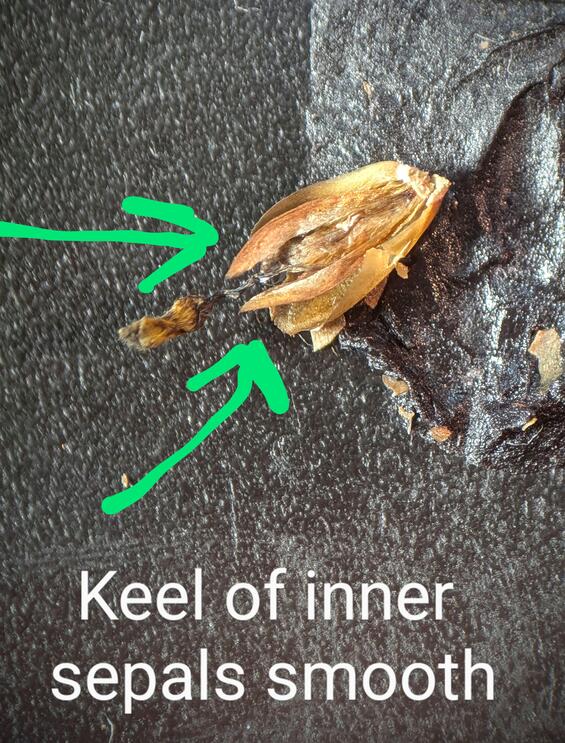
Images by Robert Wernerehl.
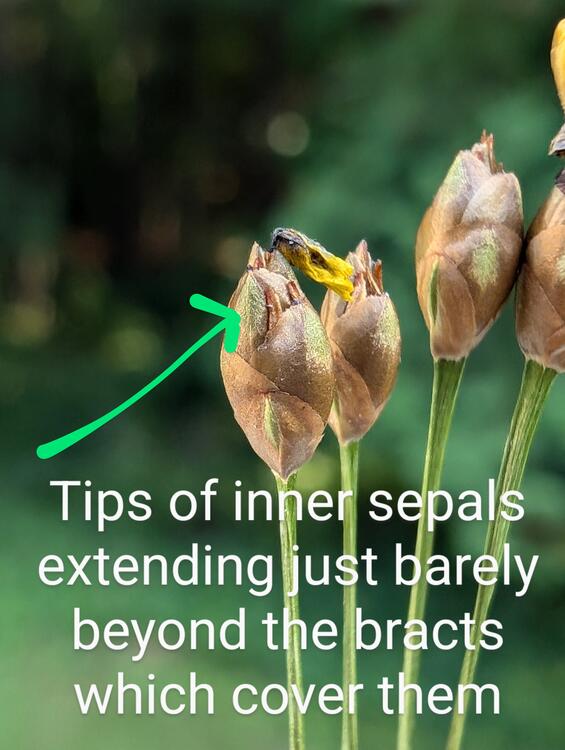
Life cycle and behavior
Northern yellow-eyed grass is an herbaceous perennial. While a specific pollination mechanism has not been identified for northern yellow-eyed grass, bees are known to be primary pollinators in the Xyridaceae, and both bees and flies have been observed visiting the flowers of yellow-eyed grass species. Some yellow-eyed grasses are through to be capable of developing seeds without fertilization, a process called apomixis, and wind may also play a role in the pollination of some flowers (Dodds 2024).
Population status
Northern yellow-eyed grass is on the Massachusetts state watch list and has been included as a species of greatest conservation need in Massachusetts. There are currently 5 occurrences of northern yellow-eyed grass in the state verified since 1990. Northern yellow-eyed grass is currently known from Berkshire, Franklin, Hampshire, Hampden and Worcester Counties, and is historically known from Middlesex County (Cullina et al. 2011, Fernald 1927). Nineteeth and early 20th century herbarium specimen records include Barnstable and Plymouth counties. In a 3000-hour fieldwork survey of all 26 towns in Franklin County over the prior decade, northern yellow-eyed grass was found only in two towns (Bertin et al 2020) and was considered rare.
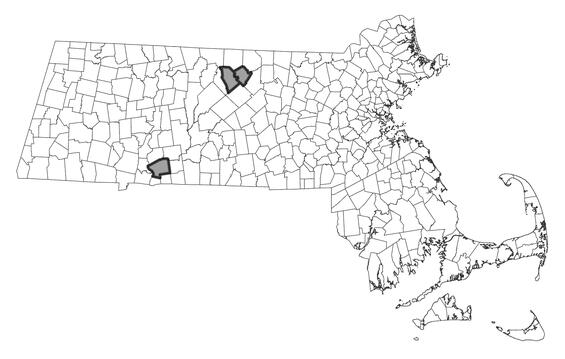
Distribution in Massachusetts
1999-2024
Based on records in the Natural Heritage Database
Distribution and abundance
Records show that Xyris montana is relatively rare across the range with only 205 research grade observations and is the most northerly in distribution of the four species that occur in Massachusetts (iNaturalist 2025). It is distributed in 12 northern US states and 5 Canadian provinces, all in eastern North America. NatureServe (2025) shows the status to be critically imperiled in Vermont, Rhode Island and New Jersey, imperiled in Massachusetts and Connecticut, secure in New York, with most populations in the Adirondacks, and variously vulnerable to apparently secure or not ranked across the rest of the region including Canada.
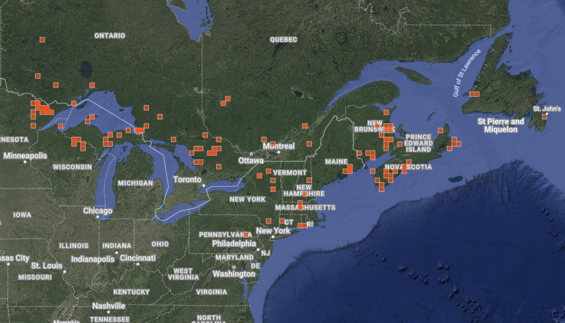
iNaturalist research grade observations of Xyris montana within the northeastern North America region as of 07 April 2025.
Habitat
Northern yellow-eyed grass is an obligate wetland species that grows in peatlands such as acidic fens, bogs, sunny edges of black spruce and tamarack, or Atlantic white cedar forests, occasionally on sphagnum mats which are seasonally inundated with water. Associated plants in these communities tend to consist of herbaceous species, such spikesedge (Eleocharis spp.), cottongrass (Eriophorum spp), horned bladderwort (Utricularia cornuta), sundew (Drosera intermedia, D. rotundifolia), wiregrass sedge (Carex lasiocarpa), blue flag (Iris versicolor), marsh St. John’s wort (Triadenum virginicum), leatherleaf (Chamaedaphne calyculata), pitcher plant (Sarracenia purpurea), Labrador tea (Rhododendron groenlandicum), large and small cranberry (Vaccinium macrocarpon and V. oxycoccos), rose pogonia (Pogonia ophioglossoides), and white beaksedge (Rhynchospora alba).
Healthy habitats are vital for supporting native wildlife and plants. Explore habitats and learn about conservation and restoration in Massachusetts.
Threats
This species has a strong northerly distribution in North America with almost all occurrences occurring north of an imaginary line between Duluth, Minnesota and Boston. As a species of more northerly distribution, climate warming is a serious threat. The past 130 years have seen a warming of 1.4 °C (2.5 °F) in the Northeast United States (Staudinger et al. 2024). Northern species can be expected to move much further north in an attempt to occupy a habitat within their evolved climate envelope. Temperature and seasonality changes also disrupt synchronization of pollinators to plant flowering.
Threats also come from succession with woody species taking over formerly open bog habitat, changes in hydrology due to development, road construction or beaver activity.
Conservation
Survey and monitoring
Much more survey work is needed to find more populations, especially because this species is small, in difficult areas to survey, and is difficult to identify and to separate from two other similar species. One approach is to review old specimen data for locations and resurvey those sites to see if the plants might still be there. Surveys of known populations are needed to establish numbers and extent of the population, and gather data on associated species, soil pH and potential threats. Once surveyed, a population should be resurveyed every five years to check on its status.
Management and research needs
Conservation planning for Xyris montana should focus on land protection and the preservation of natural habitat conditions. No immediate management needs have been identified for the species (Dodd2 2024). Research is needed on seed production, seed fertility, seed dispersal and germination.
Acknowledgements
MassWildlife acknowledges the assistance of Matthew Charpentier who initiated the development of this fact sheet.
References
Bertin, R. I., M. G. Hickler, K. B. Searcy, G. Motzkin, and P. P. Grima. 2020. Vascular Flora of Franklin County, Massachusetts. New England Botanical Club. 390 pp.
Cullina M, Connolly B, Sorrie B, Somers P (2011) The vascular plants of Massachusetts: a county checklist, 1st revision. Massachusetts Natural Heritage & Endangered Species Massachusetts Division of Fisheries and Wildlife, Westborough, MA
Dodds, Jill S. 2022. Xyris montana Rare Plant Profile. New Jersey Department of Environmental Protection, State Parks, Forests & Historic Sites, State Forest Fire Service & Forestry, Office of Natural Lands Management, New Jersey Natural Heritage Program, Trenton, NJ. 15 pp. Accessed 7 April 2025 [https://www.nj.gov/dep/parksandforests/natural/heritage/docs/xyris-montana-northern-yellow-eyed-grass.pdf ]
Fernald, Merritt Lyndon. 1927. Xyris montana in eastern Massachusetts. Rhodora 29: 222–223.
Gleason, Henry A., and Arthur Cronquist. Manual of Vascular Plants of Northeastern United States
and Adjacent Canada, Second Edition. Bronx, NY: The New York Botanical Garden, 1991.
Haines A (2011) New England Wild Flower Society’s Flora Novae Angliae: a manual for the identification of native and naturalized higher vascular plants of New England. Yale University Press. 1008 pp.
Kral, Robert. Page updated November 5, 2020. Xyris montana Ries. In: Flora of North America Editorial Committee, eds. 1993+. Flora of North America North of Mexico [Online]. 22+ vols. New York and Oxford. Accessed April 7, 2025 at http://floranorthamerica.org/Xyris_montana
NatureServe. 2025. NatureServe Network Biodiversity Location Data accessed through NatureServe Explorer [web application]. NatureServe, Arlington, Virginia. Available https://explorer.natureserve.org/. Accessed: 4/07/2025.
Staudinger, M.D., A.V. Karmalkar, K. Terwilliger, K. Burgio, A. Lubeck, H. Higgins, T. Rice, T.L. Morelli, A. D'Amato. 2024. A regional synthesis of climate data to inform the 2025 State Wildlife Action Plans in the Northeast U.S. DOI Northeast Climate Adaptation Science Center Cooperator Report. 406 p. https://doi.org/10.21429/t352-9q86
Contact
| Date published: | April 15, 2025 |
|---|